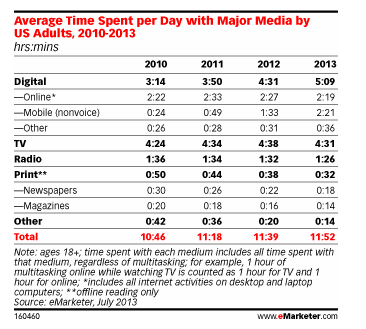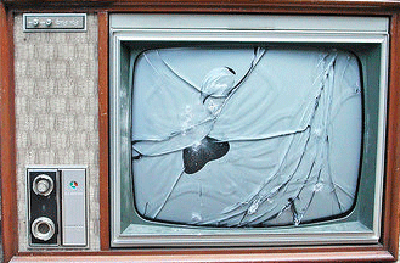At current usage levels, Americans are on track to spend as many hours consuming content on digital devices as the combined amount of time they devote to watching TV and reading print, according to eMarketer.
After compiling reports from more than 40 research institutions, eMarketer estimates that the average amount of time likely to be spent on digital media this year will climb to five hours and 9 minutes (5:09), as compared with 4:31 in 2012.
If eMarketer’s prediction is correct, then the amount of time spent with digital media will for the first time surpass the roughly 41/2 hours per day that Americans have historically watched television.
That doesn’t mean traditional TV is dead — cord cutting still only represents about 5 percent of the U.S. population, according to Nielsen – but the trend is growing.
The digital surge is being driven by the steady adoption of mobile-technology, and the sort of personalized communications experiences that are beyond the reach of many in traditional broadcast and print media.
In June, Nielsen reported that 61% of Americans own smartphones and Pew Research Center said that 34% of Americans own a tablet.
With the use of digital devices growing, eMarketer expects the consumption of newspapers, which averaged 30 minutes a day in 2010, to drop to 18 minutes in 2013. Magazines, which averaged 20 minutes in 2010, are forecast to slip to 14 minutes this year.
The declining utilization of legacy media spells further trouble for those entities who historically have generated the majority of their revenues from traditional advertising.

Spending on traditional advertising — meaning media advertising that does not use the Web or other digital channels — will decrease 2.1% over the next year, according to a survey of 410 marketing executives conducted by the Duke University Fuqua School of Business from July 16 to August 6, 2013.
The forecast is especially noteworthy because overall execs polled for the CMO Survey also predicted a 4.3% increase in marketing budgets over the next year. No surprise — much of that increase will come from a 10.1% leap in digital marketing spending, which is expected to grow across the board.
The evidence is clear. The legacy media business continues to experience decline in time spent with each medium and ad revenues, with newspapers and magazine taking the biggest hits.
The nation’s leading media companies are furiously trying to transition into digital. Some are making great strides toward building their digital revenue. Some are not going to make it.
Basic questions you can ask to keep from suffering the same fate
- Are we using digital today to provide our audience with some type of intimate or individualized experience?
- Do we have team members or partners with a grasp on how digital works and how to leverage it to accomplish our ministry and business objectives?
- Are we creating new pricing and inventory structures?
- Have we embraced the robust reporting capabilities of digital?
Answers for media ministries
Like everyone in media, those of us who work in ministry are in the middle of that same wave of technological upheaval, and it is causing rapid changes in the way the gospel is created and transmitted.
It affects (or will affect) almost everybody in the industry.
Whether we will have the people with the expertise and sufficient resources to continue as vibrant, influential media ministries is a standing question. The answers will require change, adapting what we do to new technologies and opportunities, innovating and creating new and better ways of fulfilling our mission … and a total reliance on the wisdom of God.
If you’re looking for ways to increase your usage of digital media, let’s chat! Our online video and audio platform and digital media services can help you bring your brand and ministry performance to the next level.
